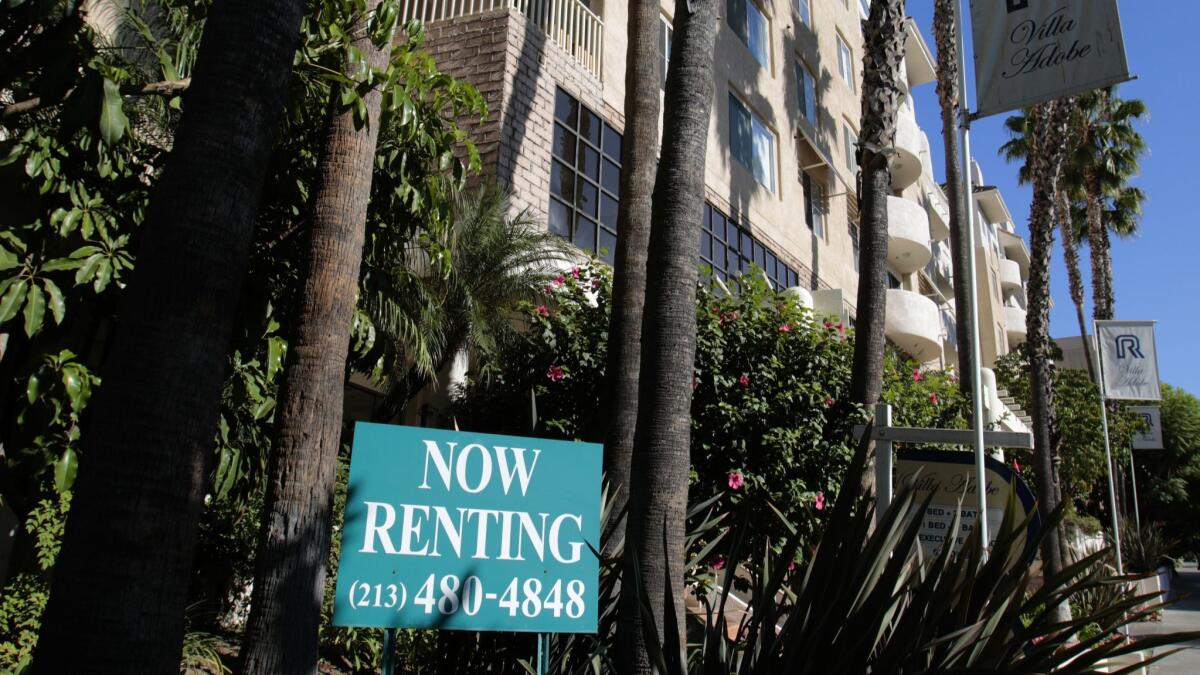Op-Ed: Housing in California is expensive, but it’s not that expensive

- Share via
California’s housing affordability crisis is on everyone’s lips these days. The state Legislature wrangled with major housing bills during this term; a measure to facilitate rent control is on the November ballot; and leading gubernatorial candidate Gavin Newsom contends that the state needs 3.5 million new housing units to adequately house Californians. All of this is fueled by a sense that housing costs in the state have simply spun out of control, and this in turn is fueled by news reports that suggest dizzying rent levels.
The New York Times, for example, reported in April 2016 that the average cost of an apartment in the San Francisco “region” was $3,500 per month. The Orange County Register reported this summer that typical rents in O.C. were nearly $1,900 per month. And the Los Angeles Times reported on October 6 that the median rent for one-bedroom units in L.A. was $2,370. Housing advocates and candidates for office often toss out even higher numbers.
Housing is expensive, but it is not that expensive. The most authoritative source on housing costs — and many other matters — is the United States Census Bureau. Every year, the census randomly selects and carefully surveys more than 1 million households, including roughly 50,000 in the greater Los Angeles region and well over 100,000 statewide. Its goal is precisely to generate accurate national and local data about population, racial makeup, jobs, school enrollment and housing costs. This American Community Survey takes a while to be compiled (what’s available now is 2016 data), but because of its sampling methods and accuracy checks, its results are by far the most reliable for housing costs.
The best response to the affordability problem is a matter of legitimate debate. But thoughtful debate must start with accurate data.
According to the survey, the median rent in California in 2016 was $1,200. The median rent in Los Angeles County was also $1,200 (for one-bedroom units, it was $1,000), and the same medians prevailed if we consider just the city of Los Angeles. In Orange County, the median rent for all apartments was $1,500. In the five-county Bay Area, the median was $1,600. Even in San Francisco, a famously high priced city in recent years, the median 2016 rent was $1,800. High numbers, certainly, but less mind-boggling than the claims filling much of our public discourse.
The inflated numbers come from private firms such as Zillow, Reis, Apartment List and other real estate brokerage firms, which generate data that are often cited by reporters and political candidates. But the data from these firms, while accurate for their individual listings, can be wildly inaccurate measures of overall price levels because they are based upon only part of the market.
Apartment brokers usually deal only with units rented by middle-class or more-affluent households. If their sample is skewed toward the high end of the market, their rent estimates will be skewed as well. Similarly, commercial services that survey apartment managers aren’t required to reach a truly representative sample. Not surprisingly, they will find it easier to locate managers of complexes in Santa Monica than an individual overseeing a five-unit building in East L.A.
To be fair, there are other factors that can partially account for the disparities between the census and commercial surveys. Some apartment rentals that show up in the American Community data are artificially cheap because, for instance, parents may rent a condo unit they own to an adult child at a subsidized rate, or they may rent a “granny flat” to a parent for a nominal amount. If we exclude from the census survey units that rent for far-below-market amounts, the medians go up, but only by about $100.
It’s also the case that on-the-market apartments generally rent for more than units where a tenant has been in residence for many years. This is partly because, under some local rent control statutes, rents reset at market levels only when they are vacated. It’s also because landlords often value longtime, stable tenants and give them a break from higher rents they might charge for a vacant unit.
Enter the Fray: First takes on the news of the minute from L.A. Times Opinion »
We can adjust for this difference by examining the survey data just for newly occupied rental units. When we do this — and we exclude the very inexpensive units — the median rent statewide in 2016, and for the city and country of Los Angeles, rises to $1,500, a figure that is plausibly more like $1,600 in 2018.
We agree that rent affordability in California is a real problem. After adjusting for inflation, median rents in California are about 50% higher than they were in 1980.
This is partly because the average quality of housing is much higher today than it was 40 years ago. Improving the housing stock has been a major goal of building codes as well as landlord-tenant law, and it has largely succeeded, but at a cost. Housing prices have also risen because of the severe restrictions in many parts of the state on new construction — in other words, there is a housing shortage. High rental prices mean that even among households with incomes above $30,000, nearly a third devote more than 30% of their income to rent.
The best response to the affordability problem is a matter of legitimate debate. But thoughtful debate must start with accurate data.
Richard Sander is a professor, and Taylor Gumm a student, at UCLA’s School of Law.
Follow the Opinion section on Twitter @latimesopinion and Facebook
More to Read
A cure for the common opinion
Get thought-provoking perspectives with our weekly newsletter.
You may occasionally receive promotional content from the Los Angeles Times.









